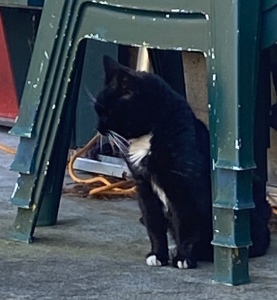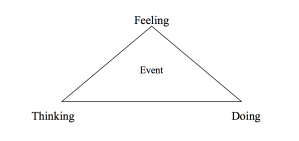I went to bed anxious last night. I’m sure that I was not the only one—and while I do have personal reasons to be very anxious, my anxiety is nothing compared to that of the protestors, the families who have lost their children, their fathers, their mothers, their cousins, their neighbors, and friends, aunts, uncles, grandchildren, grandparents. Generations of family members lost to the violence and madness of racism.
I woke up mad. Mad about everything: mad that I’ve been cooped up for months now, cut off from life as I once knew it; mad that this country seems hell bent on self-destruction; mad that we don’t have a functional leader; mad that white people cannot seem to wrap their heads around the systemic damage done by centuries of racism. Mad that I had given up my morning runs at my favorite running trail because when lockdown began, people started swarming to the same trail, no one apparently concerned about spreading germs or vectoring the virus. Mad that so many people I know cling to their Facebook accounts; mad that I still post on my Instagram feed even though I know it’s owned by Zuckerberg; mad that he and Sheryl “Lean In” Sandberg refuse to make any changes. I mean, my mad has no end. Or so it seems.
So, I did what I know to do (I’m a therapist, after all, literally schooled in these things): I tried Mindfulness and Meditating. I put down my phone and my computer for two blissful hours yesterday and went kayaking, basking in nature: ducks, herons, turtles, geese. I felt better in the moment, but today the anxiety returned, so I called my therapist for an emergency session. That helped. Buoyed, I decided to try returning to my favorite trail, for a walk, with a mask. Big Mistake.
Two other people on the trail today were wearing masks. Two! Out of dozens: old people, children, mothers pushing strollers, dads on bikes with their children. I get why runners might not wear a mask—I had trouble breathing through mine while I was walking, but put on something: a bandana, a scarf, a balaclava to pull up when approaching someone. I started to get mad again.
And then I remembered. I remembered why I had stopped going to my favorite trail (to any trails, really) for the past three months: I cannot control what anyone else does. I decided back on April 1 that I couldn’t keep coming home from my morning runs mad because so many people were suddenly out there. That was defeating the purpose. I remembered, as I felt like screaming at the other walkers today “PUT ON A DAMN MASK!” that I can only be responsible for my actions. As I felt my blood pressure rise, I remembered, that I had made a choice to be here, and if I wanted things to be different, I needed to make a different choice.
So often, when we feel miserable (mad, sad, anxious, depressed, angry, lonely), we look outside of ourselves for both the reasons and for the answers, when in actuality, the key to changing our feelings lies within. We think “if only they would change, life would be better” while we continue to do the same things, over and over and over again, expecting a different result. That, my friends, is madness. We have done the same things over and over and over again in this country. Silence hasn’t worked. Tolerance hasn’t worked. Action might.
I am reminded of a short parable, that I’ll probably butcher, but it goes something like this:
I walked down a street and fell into a hole. (Distress)
The next day, I walked down the street and walked around the hole. (Anxiety)
Finally, I walked down a different street. (Choice)
Want to stop the madness? Make a different choice.
For some, a different choice is protesting. Standing up, speaking out, marching. For others, a different choice is listening. Listening to understand, not to reply or to defend, but to hear. For others it is donating, writing, making art, singing. Reaching out. Linking arms. Lifting up.
Choose to do something.
As a counselor, I am ethically obligated to stand for social justice, to stand with those who face systemic oppression and disenfranchisement. And I do. I believe Black Lives Matter. I stand with the protestors.

 Loneliness is such a difficult emotion. When we are feeling lonely, we are probably also experiencing so many other emotions at the same time: depression, anxiety, shame, frustration, for starters. And, behind all of these feelings is probably fear: fear of being judged, fear that we will never find our people, fear of rejection.
Loneliness is such a difficult emotion. When we are feeling lonely, we are probably also experiencing so many other emotions at the same time: depression, anxiety, shame, frustration, for starters. And, behind all of these feelings is probably fear: fear of being judged, fear that we will never find our people, fear of rejection. Humans have emotions. That is just how we are wired—to feel things, to experience pleasure, pain, loss, grief, jubilation, jealousy, ecstasy, disappointment. Doubt. Trust. Trouble comes when we decide we no longer want to feel our feelings, and we undertake just about any distraction or vice to render ourselves numb: work, sex, booze, exercise, food. And in trying to avoid our original feeling, we’ve added more: guilt, just for starters.
Humans have emotions. That is just how we are wired—to feel things, to experience pleasure, pain, loss, grief, jubilation, jealousy, ecstasy, disappointment. Doubt. Trust. Trouble comes when we decide we no longer want to feel our feelings, and we undertake just about any distraction or vice to render ourselves numb: work, sex, booze, exercise, food. And in trying to avoid our original feeling, we’ve added more: guilt, just for starters. If I am to be honest right now, I have a heaviness sitting in my chest. I just finished my weekly personal therapy session and while it was great to see my therapist and know that she is healthy and well, there is also a sadness that I cannot quite describe.
If I am to be honest right now, I have a heaviness sitting in my chest. I just finished my weekly personal therapy session and while it was great to see my therapist and know that she is healthy and well, there is also a sadness that I cannot quite describe. (This is a long one, buckle up).
(This is a long one, buckle up). The old guy can’t find his food dish to save himself, but he can track me down to shatter my reverie? And in the next thought, please don’t die on me buddy. We’ve become an unlikely pair of quarantine friends. Whodda thunk it?
The old guy can’t find his food dish to save himself, but he can track me down to shatter my reverie? And in the next thought, please don’t die on me buddy. We’ve become an unlikely pair of quarantine friends. Whodda thunk it? Yesterday I wrote about pushing through the walls that tend to appear when we feel like we have failed in some way or when we want to do something but can’t quite find the motivation. Small obstacles often appear to be enormous hurdles and when we can push through the walls or find the energy to jump over the hurdles, we feel better about ourselves. We perk up because we have overcome inertia and completed something, whether it be a run, a blog, reading for school, or our taxes. Clearing our space emotionally and physically can help us feel lighter, freer.
Yesterday I wrote about pushing through the walls that tend to appear when we feel like we have failed in some way or when we want to do something but can’t quite find the motivation. Small obstacles often appear to be enormous hurdles and when we can push through the walls or find the energy to jump over the hurdles, we feel better about ourselves. We perk up because we have overcome inertia and completed something, whether it be a run, a blog, reading for school, or our taxes. Clearing our space emotionally and physically can help us feel lighter, freer. The past few weeks have been a seminar on awareness, being conscious of what is going on around me as well as within me. I have been noticing so many things. So many things. I thought I should start making a list of all the noticing but as is usually my wont, I figured I would remember. And, of course, now that I sit down to write about what I have noticed, I’m having difficulty remembering all of the things.
The past few weeks have been a seminar on awareness, being conscious of what is going on around me as well as within me. I have been noticing so many things. So many things. I thought I should start making a list of all the noticing but as is usually my wont, I figured I would remember. And, of course, now that I sit down to write about what I have noticed, I’m having difficulty remembering all of the things.
 So, I wrote in yesterday’s blog that I had taken and passed my licensure exam. The state licensing exam is also the exam used for those counselors who want to be recognized as Nationally Certified Counselors. It measures competence in several areas: Research, Theories, Assessment, Ethics, and a few other categories. Overall, I did okay on the exam. I didn’t ace it, but I did far better than the minimum requirements for licensure. Also, I totally rocked the Ethics section.
So, I wrote in yesterday’s blog that I had taken and passed my licensure exam. The state licensing exam is also the exam used for those counselors who want to be recognized as Nationally Certified Counselors. It measures competence in several areas: Research, Theories, Assessment, Ethics, and a few other categories. Overall, I did okay on the exam. I didn’t ace it, but I did far better than the minimum requirements for licensure. Also, I totally rocked the Ethics section. One of the primary strategies I use with clients is Cognitive Behavioral Therapy, or CBT. CBT posits that we too often believe our own thoughts. Think about it! Our minds generate bazillions of thoughts every day. And generally, we chose to believe what we think. And most of the time, what we believe is not even true. We make decisions based on faulty beliefs. And then we’re surprised when trouble ensues.
One of the primary strategies I use with clients is Cognitive Behavioral Therapy, or CBT. CBT posits that we too often believe our own thoughts. Think about it! Our minds generate bazillions of thoughts every day. And generally, we chose to believe what we think. And most of the time, what we believe is not even true. We make decisions based on faulty beliefs. And then we’re surprised when trouble ensues.